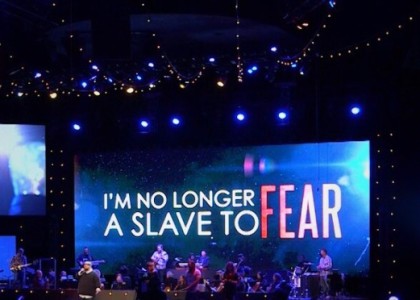Form AND Function
Published in Let’s Worship Magazine – Fall 2013
Form AND Function
For years, the entire purpose of a light fixture was to do the obvious: light up a dark area. But I want to challenge your church to explore expanding the purpose of the light fixture beyond it’s basic function and begin to look at the ways that fixture could provide a background element or set piece for a service.
Our church recently underwent a major remodel of our auditorium and platform space, but we did not have the luxury of meeting in an alternate space during those 5 months of construction. Each week we had to set up all the band equipment and create a set design that looked good on camera for I-MAG and our Video Venue campuses. Because of time and space constraints, the solution had to be simple and repeatable (function) but also look great and provide the right feel for our service (form).
The solution was to use lights as the background. We placed LED light strips on upright piece of box truss. Each truss was pre-wired and self contained. Set up and tear down were easy and the lights provided a great background that looked excellent on video and provided huge energy in the room. As an extra layer of light, we added several specialty fixtures on the ground and the light beams became another layer of the look.
What we learned was that the light fixture can move beyond the simple function of providing light in the dark and it can become an important set piece that provides layers and depth to your platform.
Here are a couple of hints as your church leverages both the function and form of a light fixture.
- Dimmer is better. The eye naturally is drawn to the brightest object in a scene.Because of this, especially during the message, you want to allow your background lights to remain in the background. These lights should not be competing with your video screens or where you want the people to look. However, if you are in a contemporary worship setting, the lights can be more of a feature during the music, but still need to melt into the background during the sermon.
- Sit in the audience. Sit where a normal person would sit and see if the light is appropriate for your environment. Every congregation and setting is different. If you have a student event, the light shining in the eyes may add energy, but that same light could create endless complaints in a traditional service. Sit in the audience and put yourself in the mindset of a normal church member before you finalize your light positions.
- Think in layers. You may have bare-bulb patio lights, LED up-lights, moving fixtures that produce light beams, and raw color wash lights all ready to use as part of your set design. But resist the urge to turn on everything all at once. Think in layers. Think in the ebb and flow of a song. Most songs have a movement to them that you can leverage to show different layers of light to create a different feel.
- Use the whole room as a canvas. The best lighting happens when you are able to break the barrier between the platform and the audience and bring the congregation into the experience. We do this in two ways. First, we light the ceiling of the auditorium with colored LED lights from the back. We match the ceiling color to the platform colors so that the audience feels immersed in color. Second, we use moving lights that produce beams of light and shoot the beams from the stage to the back of the room. These beams of light create energy in the room and further break down the barrier between the congregation and the platform.
There are so many possibilities as you explore using lighting as part of your platform design, be creative and think outside of the box.







